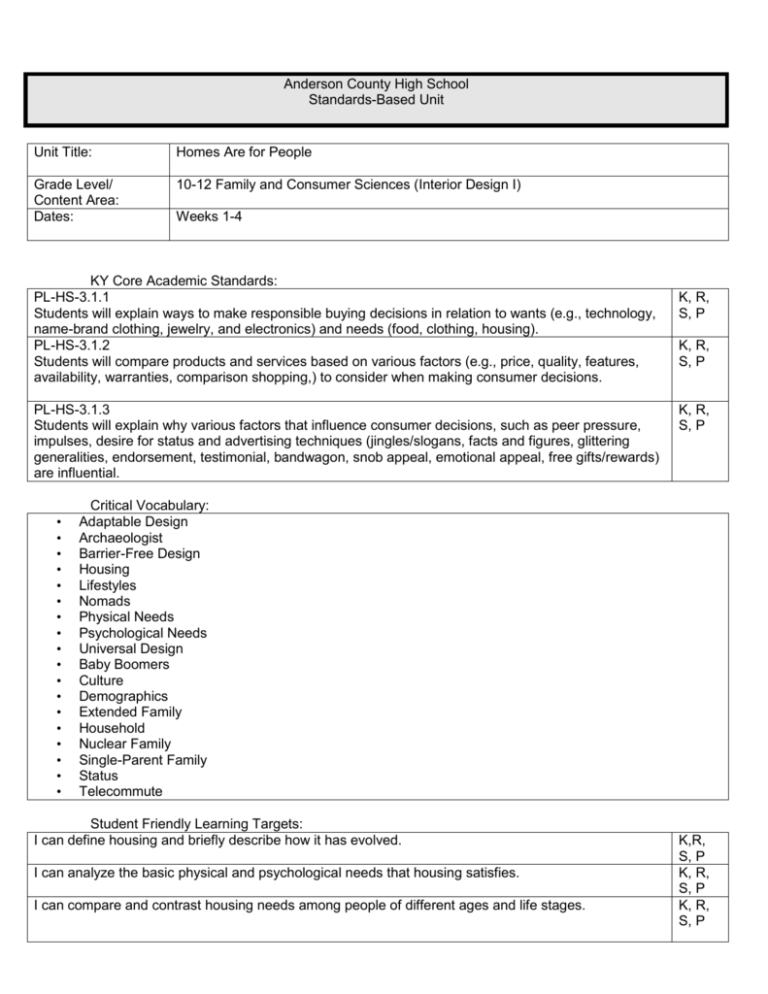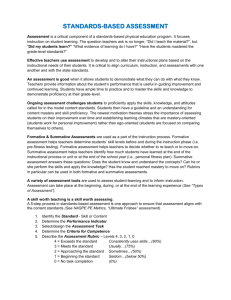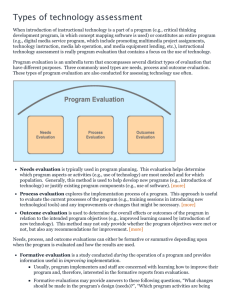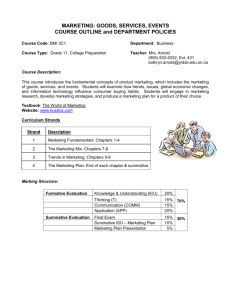Boone County Schools - Anderson County Schools
advertisement

Anderson County High School Standards-Based Unit Unit Title: Homes Are for People Grade Level/ Content Area: Dates: 10-12 Family and Consumer Sciences (Interior Design I) Weeks 1-4 KY Core Academic Standards: PL-HS-3.1.1 Students will explain ways to make responsible buying decisions in relation to wants (e.g., technology, name-brand clothing, jewelry, and electronics) and needs (food, clothing, housing). PL-HS-3.1.2 Students will compare products and services based on various factors (e.g., price, quality, features, availability, warranties, comparison shopping,) to consider when making consumer decisions. PL-HS-3.1.3 Students will explain why various factors that influence consumer decisions, such as peer pressure, impulses, desire for status and advertising techniques (jingles/slogans, facts and figures, glittering generalities, endorsement, testimonial, bandwagon, snob appeal, emotional appeal, free gifts/rewards) are influential. • • • • • • • • • • • • • • • • • • K, R, S, P K, R, S, P K, R, S, P Critical Vocabulary: Adaptable Design Archaeologist Barrier-Free Design Housing Lifestyles Nomads Physical Needs Psychological Needs Universal Design Baby Boomers Culture Demographics Extended Family Household Nuclear Family Single-Parent Family Status Telecommute Student Friendly Learning Targets: I can define housing and briefly describe how it has evolved. I can analyze the basic physical and psychological needs that housing satisfies. I can compare and contrast housing needs among people of different ages and life stages. K,R, S, P K, R, S, P K, R, S, P I can assess the importance of building homes that follow the concept of universal design. K, R, S, P K, R, S, P I can describe how housing reflects cultural views and values. I can point out ways in which cultures influence each other. K, R, S, P I can identify social trends that affect housing. K, R, S, P I can explain the major ways in which government influences housing. K, R, S, P Summative Assessment: Students will be given a unit test which includes selected response and extended written response questions. Students will create presentations that discuss several aspects of the design industry, and the impact of internal and external factors on home choices, the impact of color and elements of design, and methods of home construction. Pre-Assessment: Pre assessment for the beginning of the course will be a re-ordered version of the final exam in the course. Formative Assessments: Questioning during instruction. Section quizzes. Bell Ringers Exit Slips Test Talks/Conferencing Large Group/ Small Group Instructional Activities: Learning Target(s) Description of Strategy I can define housing and briefly describe how it has evolved. Lecture Cooperative Learning Formative/Summative Assessment Scaffolding Presentations Class Discussion I can analyze the basic physical and psychological needs that housing satisfies. Lecture Cooperative Learning Formative/Summative Assessment Scaffolding Presentations Class Discussion Preparation/ Materials Needed PPT Guided Notes Rubrics PPT Guided Notes Rubrics Notes: I can compare and contrast housing needs among people of different ages and life stages. Lecture Cooperative Learning Formative/Summative Assessment Scaffolding Presentations Class Discussion PPT Guided Notes Rubrics I can assess the importance of building homes that follow the concept of universal design. Lecture Cooperative Learning Formative/Summative Assessment Scaffolding Presentations Class Discussion PPT Guided Notes Rubrics I can describe how housing reflects cultural views and values. Lecture Cooperative Learning Formative/Summative Assessment Scaffolding Presentations Class Discussion PPT Guided Notes Rubrics I can point out ways in which cultures influence each other. Lecture Cooperative Learning Formative/Summative Assessment Scaffolding Presentations Class Discussion Lecture Cooperative Learning Formative/Summative Assessment Scaffolding Presentations Class Discussion Lecture Cooperative Learning Formative/Summative Assessment Scaffolding Presentations Class Discussion PPT Guided Notes Rubrics I can identify social trends that affect housing. I can explain the major ways in which government influences housing. PPT Guided Notes Rubrics PPT Guided Notes Rubrics Plan for students who are not successful on summative assessment: Remediation in the form of review sessions, after/before school re-takes, extended time, and parent contact. Additional Resources: Reflection: Notes: Anderson County High School Standards-Based Unit Unit Title: Grade Level/ Content Area: Dates: Architectural Design 10-12 Family and Consumer Sciences (Interior Design I) Weeks 5-7 KY Core Academic Standards: PL-HS-4.1.1 Students will analyze and evaluate why people need to work and how a person’s career choice impacts life long earning potential, career opportunities and job satisfaction. PL-HS-4.1.2 Students will identify and explain how job and career opportunities vary at the local, state and national levels and how components of the Individual Learning Plan (ILP) (e.g., interest inventories, personality test, community service, résumé, awards/recognition) can be a valuable resource for career research, selection, and preparation. PL-HS-4.1.3 Students will describe academic and non-academic benefits (e.g., communication skills, computer/technical skills, mathematical skills, scientific observation and inquiry skills, teamwork skills, work experience, professional references, insight into tasks and work environments) acquired from a range of education and training options (e.g., college, apprenticeships, internships, on-the-job training military) and interpret ways education and training can impact life-long earning potential and future career opportunities. PL-HS-4.1.4 Students will analyze information (e.g., personality, values, interests, aptitudes and abilities, learning styles) from a variety of sources (e.g., Career Interest Inventory, Learning Styles Inventory, Career Aptitude Assessment, other formal assessments, job shadowing, academic experiences/grades, extra curricular activities) and explain how the information can be used to develop career goals in an Individual Learning Plan (ILP). PL-HS-4.1.5 Students will analyze and evaluate a variety of resources (e.g., Internet, print materials, guest speakers, mentors) that could be used to determine advantages and disadvantages (e.g., preparation, salary, benefits, demands of job, location, work environment) of various occupations. PL-HS-4.1.6 Students will identify and describe supporting documentation that would be needed for the career portfolio/Individual Learning Plan (ILP): business letters (application, recommendation, follow-up) assessment data (e.g., interest, learning styles, aptitudes and abilities) résumé certifications/awards samples of work (e.g., videos, artwork, portfolio entries) records of work experiences transcripts PL-HS-4.1.7 Students will compare post-secondary options (e.g., community technical colleges, 4-year colleges, military service) that would be the most appropriate preparation for a specific career path. K, R, S, P K, R, S, P K, R, S, P K, R, S, P K, R, S, P K, R, S, P K, R, S, P PL-HS-4.2.1 Students will identify individual work habits/ethics (e.g., individual/team responsibilities, willingness to learn, integrity, respect, confidentiality, self-discipline, problem-solving, punctuality, communication skills) and explain their importance in the workplace. PL-HS-4.2.2: Students will describe team skills (setting goals, listening, following directions, questioning, communicating, problem solving, dividing work, conflict resolution, mediation) and evaluate the role of team skills in today’s workplace. PL-HS-4.3.1 Students will describe how job market changes have resulted from scientific advancements and the increased use of technology in the global economy. PL-HS-4.3.2 Students will explain the purposes of technology tools (e.g., satellite, automated phone systems, online courses, computer aided drafting (CAD), graphing calculators, spreadsheets, data bases, Internet, on-line-banking) and analyze how these impact productivity in homes, schools, and jobs. PL-HS-4.3.3 Students will explain and apply skills that are used to seek, obtain, and change jobs/careers and postsecondary opportunities: conducting a job search writing letters networking completing an application securing a letter of reference preparing a résumé applying interview techniques (e.g., learn about employer/job, questions to ask, materials to take, answers to questions you may be asked, verbal and nonverbal communication) using proper procedures when changing jobs (e.g., give advance notice, write a letter of resignation) • • • • • • • • • • • • • • • • • • • • • • • • • • • Critical Vocabulary: Adobe Cape Cod House Clapboard Coquina Dormer Ell Gable Roof Gables Gambrel Roof Garrison House Half-Timbered House Pitched Roof Pueblo Saltbox House Shingle Stucco Thatch Bungalow Cornice Fanlight Gingerbread Hip Roof Mansard Roof Pediment Pilasters Portico Tenement K, R, S, P K, R, S, P K, R, S, P K, R, S, P K, R, S, P • • • • • • • • • • Aesthetic Codes Building Codes Closed Plan Floor Plan Open Plan Private Zone Service Zone Social Zone Traffic Pattern Zoning Laws • Student Friendly Learning Targets: I can describe how Native American housing was influenced by culture and environment. • I can identify primitive dwellings used by the early colonists. • I can analyze the characteristics of early English, German, and Dutch, Swedish, Spanish, and French homes in North America. K, R, S, P • I can evaluate how events in America’s history have affected housing design. K, R, S, P • I can compare and contrast housing styles in the 18th century. K, R, S, P I can compare and contrast housing styles in the 19th century. I can evaluate historical housing elements that influenced 20th century designs. K, R, S, P K, R, S, P K, R, S, P K, R, S, P • I can analyze the uniqueness of housing designs in the late 20th and early 21st centuries. K, R, S, P • I can explain how planning and regulation are used to assure quality of life in new housing developments. K, R, S, P • I can describe how lifestyle changes are reflected in housing. • I can describe the various activity zones in a home and evaluate their importance. • I can distinguish between open and closed floor plans. • I can identify factors to consider when evaluating a floor plan. K, R, S, P K, R, S, P K, R, S, P K, R, S, P • I can analyze the advantages and drawbacks of various floor plan options. K, R, S, P • I can identify recent developments in housing design. K, R, S, P Summative Assessment: Students will be given a unit test which includes selected response and extended written response questions. Students will create presentations that discuss several aspects of the design industry, and the impact of internal and external factors on home choices, the impact of color and elements of design, and methods of home construction. Pre-Assessment: Pre assessment will include all questions on the summative course exam. Formative Assessments: Questioning during instruction. Section quizzes. Bell Ringers Exit Slips Test Talks/Conferencing Large Group/ Small Group Instructional Activities: Preparation/ Materials Needed PPT Guided Notes Rubrics Learning Target(s) Description of Strategy I can describe how Native American housing was influenced by culture and environment. Lecture Cooperative Learning Formative/Summative Assessment Scaffolding Presentations Class Discussion I can identify primitive dwellings used by the early colonists. Lecture Cooperative Learning Formative/Summative Assessment Scaffolding Presentations Class Discussion Lecture Cooperative Learning Formative/Summative Assessment Scaffolding Presentations Class Discussion PPT Guided Notes Rubrics Lecture Cooperative Learning Formative/Summative Assessment Scaffolding Presentations Class Discussion Lecture Cooperative Learning Formative/Summative Assessment Scaffolding Presentations Class Discussion Lecture Cooperative Learning Formative/Summative Assessment PPT Guided Notes Rubrics I can analyze the characteristics of early English, German, and Dutch, Swedish, Spanish, and French homes in North America. I can evaluate how events in America’s history have affected housing design. I can compare and contrast housing styles in the 18th century. I can compare and contrast housing styles in the 19th century. PPT Guided Notes Rubrics PPT Guided Notes Rubrics PPT Guided Notes Rubrics Notes: I can evaluate historical housing elements that influenced 20th century designs. I can analyze the uniqueness of housing designs in the late 20th and early 21st centuries. I can explain how planning and regulation are used to assure quality of life in new housing developments. I can describe how lifestyle changes are reflected in housing. I can describe the various activity zones in a home and evaluate their importance. I can distinguish between open and closed floor plans. I can identify factors to consider when evaluating a floor plan. I can analyze the advantages and drawbacks of various floor plan options. I can identify recent developments in housing design. Scaffolding Presentations Class Discussion Lecture Cooperative Learning Formative/Summative Assessment Scaffolding Presentations Class Discussion Lecture Cooperative Learning Formative/Summative Assessment Scaffolding Presentations Class Discussion Lecture Cooperative Learning Formative/Summative Assessment Scaffolding Presentations Class Discussion Lecture Cooperative Learning Formative/Summative Assessment Scaffolding Presentations Class Discussion Lecture Cooperative Learning Formative/Summative Assessment Scaffolding Presentations Class Discussion Lecture Cooperative Learning Formative/Summative Assessment Scaffolding Presentations Class Discussion Lecture Cooperative Learning Formative/Summative Assessment Scaffolding Presentations Class Discussion Lecture Cooperative Learning Formative/Summative Assessment Scaffolding Presentations Class Discussion Lecture Cooperative Learning Formative/Summative Assessment PPT Guided Notes Rubrics PPT Guided Notes Rubrics PPT Guided Notes Rubrics PPT Guided Notes Rubrics PPT Guided Notes Rubrics PPT Guided Notes Rubrics PPT Guided Notes Rubrics PPT Guided Notes Rubrics PPT Guided Notes Rubrics Scaffolding Presentations Class Discussion Plan for students who are not successful on summative assessment: Remediation in the form of review sessions, after/before school re-takes, extended time, and parent contact. Additional Resources: Reflection: Notes: Anderson County High School Standards-Based Unit Unit Title: Using Design Grade Level/ Content Area: Dates: 10-12 Family and Consumer Sciences (Interior Design I) Weeks 8-12 KY Core Academic Standards: PL-HS-3.1.2 Students will compare products and services based on various factors (e.g., price, quality, features, availability, warranties, comparison shopping,) to consider when making consumer decisions. PL-HS-3.1.3 Students will explain why various factors that influence consumer decisions, such as peer pressure, impulses, desire for status and advertising techniques (jingles/slogans, facts and figures, glittering generalities, endorsement, testimonial, bandwagon, snob appeal, emotional appeal, free gifts/rewards) are influential. • • • • • • • • • • • • • • • • • • • • • • • • • • • • • • Critical Vocabulary: Color Form Harmonious Design Line Space Texture Accented Neutral Analogous Color Scheme Complement Complementary Hue Intensity Monochromatic Pigments Shade Split-Complementary Tint Triadic Value Asymmetrical Balance Eclectic Emphasis Golden Rectangle Golden Section Gradation Opposition Proportion Radiation Repetition K, R, S, P K, R, S, P • • • • • Rhythm Scale Symmetrical Balance Transition Unity Student Friendly Learning Targets: I can describe the elements of good design and why they are useful. I can explain the feelings that space can convey, and suggest how to change the apparent size of a space. K, R, S, P K, R, S, P I can demonstrate ways to use line to create specific effects. K, R, S, P I can analyze the effects created by forms and shapes in particular designs. K, R, S, P K, R, S, P I can illustrate how texture can be used to create desired effects. I can analyze how color can be used to create moods and illusions. I can explain how primary colors are used to produce other colors on the color wheel. K, R, S, P K, R, S, P I can describe the effects of intensity and value on various hues. K, R, S, P I can identify the characteristics of different types of color schemes. K, R, S, P I can describe factors to consider when planning a color scheme. K, R, S, P I can analyze ways that proportion is used in effective design. K, R, S, P I can analyze scale and the ways it is used in design. K, R, S, P I can implement the types of balance. K, R, S, P I can explain ways to achieve various types of rhythm. K, R, S, P I can describe how to create emphasis. K, R, S, P I can assess the importance of balancing unity with variety. K, R, S, P Summative Assessment: Students will be given a unit test which includes selected response and extended written response questions. Students will create presentations that discuss several aspects of the design industry, and the impact of internal and external factors on home choices, the impact of color and elements of design, and methods of home construction. Pre-Assessment: Pre assessment will include all questions on the summative course exam. Formative Assessments: Questioning during instruction. Section quizzes. Bell Ringers Exit Slips Test Talks/Conferencing Large Group/ Small Group Instructional Activities: Learning Target(s) Description of Strategy I can describe the elements of good design and why they are useful. Lecture Cooperative Learning Formative/Summative Assessment Scaffolding Presentations Class Discussion I can explain the feelings that space can convey, and suggest how to change the apparent size of a space. Lecture Cooperative Learning Formative/Summative Assessment Scaffolding Presentations Class Discussion Lecture Cooperative Learning Formative/Summative Assessment Scaffolding Presentations Class Discussion Lecture Cooperative Learning Formative/Summative Assessment Scaffolding Presentations Class Discussion Lecture Cooperative Learning Formative/Summative Assessment Scaffolding Presentations Class Discussion Lecture Cooperative Learning Formative/Summative Assessment Scaffolding Presentations Class Discussion Lecture Cooperative Learning I can demonstrate ways to use line to create specific effects. I can analyze the effects created by forms and shapes in particular designs. I can illustrate how texture can be used to create desired effects. I can analyze how color can be used to create moods and illusions. I can explain how primary colors are used to produce Preparation/ Materials Needed PPT Guided Notes Rubrics PPT Guided Notes Rubrics PPT Guided Notes Rubrics PPT Guided Notes Rubrics PPT Guided Notes Rubrics PPT Guided Notes Rubrics PPT Guided Notes Notes: other colors on the color wheel. I can describe the effects of intensity and value on various hues. I can identify the characteristics of different types of color schemes. I can describe factors to consider when planning a color scheme. I can analyze ways that proportion is used in effective design. I can analyze scale and the ways it is used in design. I can implement the types of balance. I can explain ways to achieve various types of rhythm. I can describe how to create emphasis. I can assess the importance of balancing Formative/Summative Assessment Scaffolding Presentations Class Discussion Lecture Cooperative Learning Formative/Summative Assessment Scaffolding Presentations Class Discussion Lecture Cooperative Learning Formative/Summative Assessment Scaffolding Presentations Class Discussion Lecture Cooperative Learning Formative/Summative Assessment Scaffolding Presentations Class Discussion Lecture Cooperative Learning Formative/Summative Assessment Scaffolding Presentations Class Discussion Lecture Cooperative Learning Formative/Summative Assessment Scaffolding Presentations Class Discussion Lecture Cooperative Learning Formative/Summative Assessment Scaffolding Presentations Class Discussion Lecture Cooperative Learning Formative/Summative Assessment Scaffolding Presentations Class Discussion Lecture Cooperative Learning Formative/Summative Assessment Scaffolding Presentations Class Discussion Lecture Cooperative Learning Rubrics PPT Guided Notes Rubrics PPT Guided Notes Rubrics PPT Guided Notes Rubrics PPT Guided Notes Rubrics PPT Guided Notes Rubrics PPT Guided Notes Rubrics PPT Guided Notes Rubrics PPT Guided Notes Rubrics PPT Guided Notes unity with variety. Formative/Summative Assessment Scaffolding Presentations Class Discussion Rubrics Plan for students who are not successful on summative assessment: Remediation in the form of review sessions, after/before school re-takes, extended time, and parent contact. Additional Resources: Reflection: Notes:






